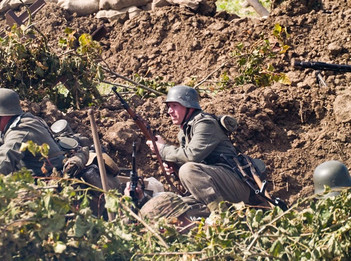8 Pieces of WW2 German Reenactment Gear Every Reenactor Needs
Apr 5th 2022
Interested in getting involved in WW2 reenactment, particularly on the German side? It’s popular with a wide range of collectors and reenactors across the world, particularly in Europe, Canada, and the United States, with a number of organizations hosting reenactments in various places across the world.
Many of these organizations have very strict requirements for what you can carry, with respect to authenticity and appearance. These are some of the most basic and essential pieces of WW2 German reenactment gear that every German reenactor should own.
M43 Tunic
Although herringbone twill (HBT) tunics were relatively uncommon in the Heer (German Army) until the middle of the war, the M43 tunic was one of the most iconic pieces of uniform issued.
By the end of the war, the M43 tunic had come to be associated with the German Army. If you’re looking for a basic field tunic to trick out with medals and other insignia, a high-quality M43 tunic is the perfect blank slate for that project.
A Mauser K98k
The Mauser Karabiner 98 Kurz was the most widely carried German rifle of the Second World War. It was carried by all branches of the German military during World War II and saw action in every theater in which they were involved.
A Mauser K98k is not just a valuable addition to a collection of WW2 German reenactment gear - it is also a rifle that is still relevant in the modern world, as a rifle platform for hunting, competition, or other recreational shooting sports.
A Non-Firing Luger
The classic P08 Luger was actually developed long before WWII, and technically it was replaced by 1938 by a more contemporary Walther handgun. Nonetheless, wartime demand coupled with the legendary reliability of the Luger pistol kept production running until midway through the war.
As a result, Lugers were widely carried by German military forces throughout WWII and the image of the Luger with its stocky frame and thin barrel is inseparable from the popular perception of Nazi Germany.
We carry a wide range of non-firing replica guns here at SARCO, Inc., including non-firing Lugers that are historically authentic and perfect for reenactments and military collections.
Marschstiefel, A.K.A. Jackboots
German Marchstiefel, more commonly known as jackboots, might just be the single most classic piece of WW2 German reenactment gear out there.
The original German “jackboots” were issued in brown, not black - soldiers would then blacken and polish them before service. They were made with heavy, thick leather and featured hobnailed-soles and ironed-heels, which them much more durable and wear-resistant in the face of hard use.
No collection of WW2 German reenactment gear is complete without a pair of German jackboots.
An M35 or M42 Stahlhelm
Both the M35 and M42 Stahlhelm are iconically German. They, more than any other symbol, represent the image of Nazi Germany, especially in the popular mindset.
These helmets are immediately recognizable with their broad, sweeping necks and wide visors, even from a distance. They’re so recognizable and influential that some have hailed them as the greatest helmet designs of all time - the design even influenced the shape and style of Darth Vader’s helmet.
While the original Stahlhelm helmets were issued way back in 1916, these are ideal additions to any collection of reenactment gear.
M31 Breadbag
The M31 Breadbag, also known as the M31 Brotbeutel was a fundamental piece of field gear carried but most if not all German soldiers. It was issued for the purposes of containing and organizing rations and most soldiers used it to carry their canteens and mess kits as well.
Small details like an M31 breadbag - particularly an authentic reproduction - can make any collection of WW2 German reenactment gear seem so much more credible. Add one to your collection and it’ll really offer the finishing touch.
A Fallschirmjager Gravity Knife or a German Boot Knife (or Both)
The Fallschirmjager-messer, also known as the FJM or gravity knife, was a utility knife issued to members of the Fallschirmjager troops, German Air Force paratroopers. It could be operated with one hand and featured a blade for cutting through parachute lines as well as a marlinspike for working through knots.
Another iconic design is the classic German boot knife. Originals were offered in a variety of sizes and styles but commonly featured a 5”+ blade with a short crossguard, a coffin-esque style handle, and a black leather sheath.
Both of these knives can serve as fine historical details that can make a German reenactment ensemble seem that much more credible.
Eisernes Kreuz, A.K.A. Iron Cross Medal
The Iron Cross is a German military decoration that long predates Nazi Germany and was popular in Prussia as well as in Imperial Germany. However, the basic design was incorporated in many different Nazi Germany military awards, including the First and Second Class Iron Crosses, of which there were several million issued during the Second World War.
A must-have addition to any collection of German Military, and distinctively Teutonic.
Contact Us for Assistance!
Have any questions about our collection of WW2 German reenactment gear, or what you need to get to complete an authentic collection? Either come visit us at our location in Easton, Pennsylvania at 50 Hilton Street, or give us a call at 610-250-2960 and we’d be glad to help.

